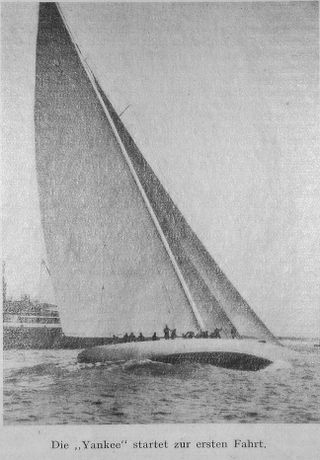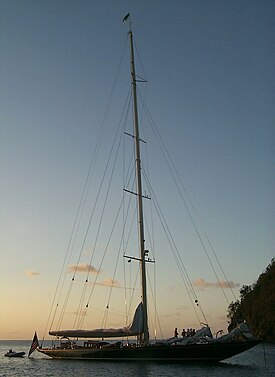
Sir Thomas Johnstone Lipton, 1st Baronet was a Scotsman of Ulster-Scots parentage who was a self-made man, as company founder of Lipton Tea, merchant, philanthropist and yachtsman who lost 5 straight America's Cup races.

The J Class of racing yachts were built to the specifications of Nathanael Herreshoff's Universal Rule. The J Class is considered the apex of the era when the Universal Rule determined eligibility in the America's Cup.

Reliance was the 1903 America's Cup defender designed by Nat Herreshoff.

The J-class yacht Velsheda was designed by Charles Ernest Nicholson and built in 1933 by Camper and Nicholsons at Gosport, Hampshire. She was built for businessman William Lawrence Stephenson and between 1933 and 1936, she won many races and competed with other yachts of her era such as Britannia, Endeavour and Shamrock V.
Fairey Marine Ltd, latterly known as FBM Marine, was a boat building company based on the River Hamble, Southampton, England. The company was created in the late 1940s by Sir Charles Richard Fairey and Fairey Aviation's managing director, Mr. Chichester-Smith. Both were avid sailing enthusiasts along with Chichester-Smith's good friend and former Olympic yachtsman, Charles Currey.

His Majesty's Yacht Britannia was a gaff-rigged cutter built in 1893 for RYS Commodore Albert Edward, Prince of Wales. She served both himself and his son King George V with a long racing career.

Lulworth is a racing yacht that was built in Southampton in 1920.

Endeavour is a J-class yacht built for the 1934 America's Cup by Camper and Nicholson in Gosport, England. She was built for Thomas Sopwith who used his aviation design expertise to ensure the yacht was the most advanced of its day with a steel hull and mast. She was 130-foot (40 m) and launched in 1934 and won many races in her first season including against the J's Velsheda and Shamrock V. She failed in her America's Cup challenge against the American defender Rainbow but came closer to lifting the cup than any other until Australia II succeeded in 1983.

Charles Ernest Nicholson was a British yacht designer.

Endeavour II was a 1936 yacht of the J Class and unsuccessful challenger of the 1937 America's Cup. It was ordered by Thomas Sopwith, designed by Charles Ernest Nicholson and built at Camper and Nicholsons. Endeavour II was scrapped in 1968.
Enterprise was a 1930 yacht of the J Class and successful defender of the 1930 America's Cup for the New York Yacht Club. It was ordered by a syndicate headed by Vice-Commodore Winthrop Aldrich, designed by Starling Burgess, and built by Herreshoff Manufacturing Company.
Whirlwind was a 1930 yacht of the J Class built as a contender for the New York Yacht Club's defence of the 1930 America's Cup. She was ordered by a syndicate headed by Landon Ketchum Thorne, designed by Lewis Francis Herreshoff, and built by Lawley & Son. Whirlwind was unsuccessful in her bid to become the Cup defender, an honor that went to Enterprise. She never sailed again after the Cup races, and was scrapped in 1935.

Yankee was a 1930 yacht of the J Class built as a contender for the New York Yacht Club's defence of the 1930 America's Cup. She was ordered by a syndicate from the Eastern Yacht Club of Boston, organized by John Silsbee Lawrence, designed by Frank Cabot Paine, and built by Lawley & Son. Whirlwind was unsuccessful in her bid to become the Cup defender, an honor that went to Enterprise. With modifications, she took part in the trials for the 1934 America's Cup. She was eventually taken to the United Kingdom by a new owner in 1935 and was scrapped in 1941.
Weetamoe was a 1930 yacht of the J Class built as a contender for the New York Yacht Club's defence of the 1930 America's Cup. She was ordered by a syndicate headed by Junius Morgan, designed by Clinton Hoadley Crane, and built by Herreshoff Manufacturing Company. Weetamoe was unsuccessful in her bid to become the Cup defender, an honor that went to Enterprise. She continued to sail for a few years afterwards, before being scrapped in 1937.

Edward Isaac Sycamore (1855-1930) was a British sailing skipper widely regarded as the leading British yacht skipper of his generation during 1890 to 1929. He was often referred to as Syc and later Old Syc.
Camper and Nicholson was a yacht design and manufacturing company based in Gosport, England, for over two hundred years, constructing many significant vessels, such as Gipsy Moth IV and Prince Philip's yacht Bloodhound. Its customers included Thomas Sopwith, William Kissam Vanderbilt II and George Spencer-Churchill, 6th Duke of Marlborough. Its yachts competed in The America's Cup, The Fastnet Race, the Olympics, the Ocean Race and many other yacht races. It also built a number of small warships, notably during the two World Wars, and some as late as the 1950s.
The 1930 America's Cup was the 14th challenge for the Cup. It took place in Newport and consisted of a series of races between the defender Enterprise, entered by a syndicate of New York Yacht Club members headed by Winthrop Aldrich, and Shamrock V, the fifth in Sir Thomas Lipton's line of Cup challengers.
The 1934 America's Cup was the 15th challenge for the Cup. It took place in Newport and consisted of a series of races between the defender Rainbow, entered by a syndicate of New York Yacht Club members headed by Harold S. Vanderbilt, and Endeavour, owned by Sir Thomas Sopwith.
The 1937 America's Cup was the 16th challenge for the Cup. It took place in Newport and consisted of a series of races between the defender Ranger, entered Harold S. Vanderbilt, and Endeavour II, the second in Sir Thomas Sopwith's line of Cup challengers.
The America's Cup is the oldest international competition still operating in any sport.












